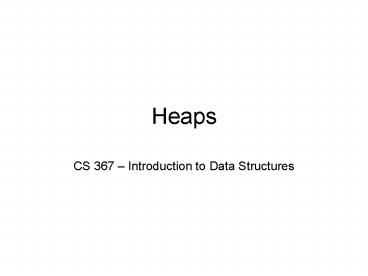Heaps - PowerPoint PPT Presentation
Title:
Heaps
Description:
parent = (index - 1) / 2 // must be integer division ... the new root with both of its children. if either of the nodes children are larger, swap it with the ... – PowerPoint PPT presentation
Number of Views:42
Avg rating:3.0/5.0
Title: Heaps
1
Heaps
- CS 367 Introduction to Data Structures
2
Heap
- A heap is a tree that satisfies the following
conditions - largest element in tree is located at the root
- each node has a larger value than its children
- tree is balanced and the leaves on the last level
are all as far left as possible
3
Valid Heaps
root
root
Z
Z
X
M
X
M
T
N
J
L
T
N
4
Invalid Heaps
root
root
X
X
Z
M
Z
M
T
N
J
L
T
J
Level 2 has a value higher than level 1
Nodes not all to left
5
Heap Applications
- Great for priority queues
- highest priority item always at the root
- just pop it off and re-sort the heap
- Can be used to sort data (called heap sort)
- put the data in a heap
- remove the root and re-sort
- keep repeating this until the heap is empty
- data was all removed in descending order
6
Implementing Heaps
- An elegant implementation is to use an array
- Re-consider the breadth first search
- dequeue a node from the head of the queue
- enqueue the nodes children in queue
- What if the node wasnt actually removed?
- instead, its children were just enqueued
7
Implementing Heaps
Z
1
3
4
6
0
2
5
X
M
queue
Z
X
M
T
N
J
L
T
N
J
L
8
Implementing Heaps
- The previous example shows that a tree can be
represented by an array - the children of a node can be found with the
following equations - child1 index 2 1
- child2 index 2 2
- the parent of a node can be found with the
following equation - parent (index - 1) / 2 // must be integer
division - this only works if the tree is balanced and all
nodes are as far left as possible
9
Implementing Heaps
- Basic class for a heap
- class Heap
- Object heap
- int end
- public Heap(int size)
- heap new Objectsize
- end 0
- public boolean insert(Object data)
- public Object delete()
10
Inserting into Heap
- Place new node at very end of the array
- the index indicated by the end variable
- Compare the added node with its parent
- if it is greater than the parent, swap the two
elements - repeat this process until it is no longer greater
than its parent or the root is reached - This algorithm percolates an inserted node toward
the root as long as it is larger than its parent
11
Inserting into Heap
- private boolean insert(Object data)
- if(end heap.length) return false
- heapend data
- int pos end
- int parent (pos 1) / 2
- while((pos ! 0) (heappos gt heapparent)
- swap(pos, parent)
- pos parent
- parent (pos 1) / 2
- end
- return true
12
Deleting from Heap
- Remove the first element in the array
- this is the root of the tree highest value
- Move the last element in the array into the root
position - Compare the new root with both of its children
- if either of the nodes children are larger, swap
it with the largest one - repeat this procedure until the node is larger
than both of its children or it has become a leaf - Now the node trickles down the tree as long as
either of its children are larger than it
13
Deleting from Heap
- public Object delete()
- if(end 0) return null
- Object data heap0
- end--
- if(end 0) return
- int pos 0 int child 1
- heappos heapend
- while((child lt end-1)
- ((heappos lt heapchild) (heappos lt
heapchild1))) - if(heapchild lt heapchild 1) child
- swap(pos, child)
- pos child
- child pos 2 1
- if((child end 1) (heappos lt
heapchild)) - swap(pos, child)































